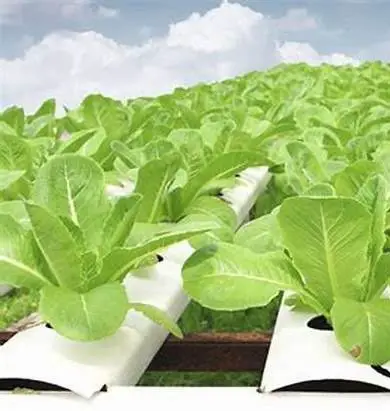Alternative forms of gardening, such as hydroponics and aeroponics, do not rely on soil for growth. Often, hydroponics and aeroponics are confused together because they are quite similar. They both involve growing crops without soil. However, there is a key difference in the nutrient delivery methods. Both methods use less water and resources than soil gardening, but one method uses resources better than the other.
Aeroponics
 In aeroponics, the medium of growth is neither soil nor water. Individual plants survive in this style of gardening by exposing the roots of plants to air. An aeroponic plant is kept alive by spraying water and other essential nutrients on the plant roots regularly. Aeroponic growth is often misunderstood as hydroponics due to its nutrient-rich mist. In an enclosed growing chamber, plants are suspended into the air once they’ve been started. The nutrient mist will be applied to the plants here for their entire lives several times per day. In the growing chamber, lighting and temperature are controlled.
In aeroponics, the medium of growth is neither soil nor water. Individual plants survive in this style of gardening by exposing the roots of plants to air. An aeroponic plant is kept alive by spraying water and other essential nutrients on the plant roots regularly. Aeroponic growth is often misunderstood as hydroponics due to its nutrient-rich mist. In an enclosed growing chamber, plants are suspended into the air once they’ve been started. The nutrient mist will be applied to the plants here for their entire lives several times per day. In the growing chamber, lighting and temperature are controlled.
- Aeroponic systems and hydroponics both use a nutrient-rich water solution.
- In comparison with hydroponics, aeroponics has no growing medium, while hydroponics utilizes water.
- Plants are held in place using foam sheets, plastic clips, or boards in an aeroponic garden.
Hydroponics
Water replaces soil in hydroponic gardening. To help hydroponic plants survive, a nutrient solution or nutrient mixture is added to the water. Seedlings are usually planted in smaller versions of perlite, rock wool, clay pellets, or clay pebbles. The seedlings are then transferred to a container filled with a water supply in a hydroponic garden. A controlled environment is provided by controlling the temperature, lighting, and humidity in the containers. In a hydroponic system, numerous plants will grow. With hydroponics systems, you can invest in hydroponic nutrients, add them to your nutrient reservoir, and allow the system to do the work.
Pros and Cons of Aeroponics
It is possible for clean and efficient plant growth with aeroponics. You can produce crops very quickly with high yields. Planting crops year-round is feasible, as they are not susceptible to disease or infection. The downside of using aeroponic gardening systems is the cost of purchasing all of the equipment required to get started. Additionally, you’ll need a space indoors where you can install a system.
- Water replaces soil in hydroponic gardening.
- A controlled environment is provided for the cultivation of plants by controlling the containers’ temperature, lighting, and humidity.
- The overall effectiveness of aeroponics is higher than that of some hydroponic systems, in particular DWC (deep water culture) and similar methods (Kratky method and wick system).
- Any disturbance to the flow of liquid nutrients is a major concern in hydroponic and aeroponic systems.
Pros and Cons of Hydroponic Setups
An advantage of using a hydroponic gardening system is that it requires less maintenance in the growth of plants, is year-round, and has a controlled climate. Despite this, there are a few disadvantages to hydroponic gardens. The cost of lighting, which is expensive in a hydroponic system, is the main reason for its high price. There is also the possibility of costly mistakes and trials when learning hydroponic gardening.
Additional FAQs
What is a hydroponic growth medium?
Hydroponic plants are typically grown in net pots or trays filled with chemically inert media such as perlite, clay pellets, rock wool, sand, or gravel.
What are the effects of power outages?
Hydroponic systems, especially deep-water ones, aren’t affected much by power outages.
What are the risks of using nutrient film?
Once the power is back on, they increase their output as before, although in systems using the nutrient film technique, you could damage the plants if the pumps are off for too long.
What is a water pump?
Water is then powered through the line and up to the grow tray using a submersible pump or an inline pump.
How do aeroponic and hydroponic systems cycle?
The most common way plants receive essential nutrients in aeroponic systems, and hydroponic systems is through timed cycling.
How long does it take to mist?
The misting is done in intervals of about 5 minutes to prevent large droplets of water.
What is a water reservoir?
Under the plants is a reservoir of nutrient solution (although some gardeners opt for a more complicated setup, where the reservoir is detached and water lines are run between the roots and the reservoir).
What happens when I use a drip irrigation system?
Whenever there is a run-off, the water naturally drains back into the reservoir.
What are the environmental benefits of aeroponics and hydroponics?
Aeroponics and hydroponics are more resource-efficient, especially in water usage than traditional soil gardening. Gardeners must make sure they have enough nozzles (and that they’re situated optimally) to reach all areas of roots.
How do you get started with hydroponic growing?
Gardeners have a wide range of hydroponic growing options to choose from, some of which they build themselves at home and others even in the classroom.

